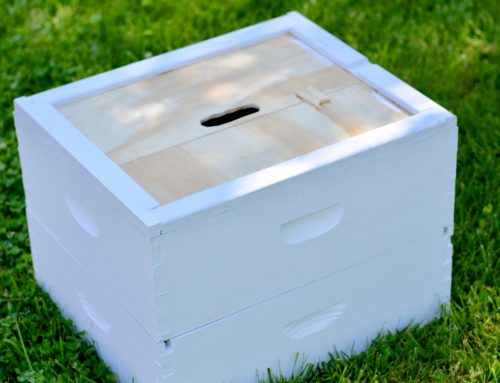A swarm of bees. The very thought makes the average person shutter. A hoard of stinging insects is the last thing one hopes to encounter. The image of Winnie the Pooh hastily fleeing from hundreds of infuriated cartoon honeybees comes readily to mind. A bee swarm is no reason to panic however. To a beekeeper, spotting a swarm of bees is as good finding as buried treasure.
When people mention a “bee swarm,” they are nearly always referring to the temporary congregation of homeless bees. A swarm can be very intimidating especially if they are clustered in your yard, on your house, or if they are literally swarming in the air around you. No matter how intimating they look, honeybee swarms are nothing to be afraid of. Honeybees are docile creatures in general, they use their sting very cautiously because using it is a suicide mission.
What exactly is a honeybee swarm? In short, a swarm is nature’s way of honeybee reproduction. A swarm is a dividing of the kingdom. In the spring honeybees analyze their current residence to determine whether they have ample room for growth in the upcoming season. If the colony feels cramped, they begin making preparations to split into two colonies. Once all the preparations are complete, the colony bids farewell to the current queen along with a band of faithful worker bees. The bees then exit and temporarily gather on a safe resting place, often a tree limb, and the worker bees cluster around the queen to protect her. The group sends off scout bees to search for a permanent dwelling place. Once the they have found the perfect home, the scout bees will direct the entire swarm to their new residence. Then the new colony begins the arduous task of making and filling fresh comb.
In the wild swarms are a great thing! A swarm means a new honeybee colony and the proliferation of good honeybee genetics. To commercial and hobby beekeepers swarming is risky and not productive. Swarming is risky because the bees are sending off a proven queen. The queen who has successfully produced honey for the last year and brought the colony through the winter leaves the hive. Not only is the proven queen gone, but the colony could potentially end up queenless. When a colony swarms the remaining bees transfer an egg into a queen cup and feed the larva royal jelly in order to raise a new queen. The bees don’t, however, place all of their eggs in one basket (no pun intended). They actually raise multiple queens in case one of the eggs fails to hatch. This results in multiple queens, but we all know that a colony can only have one queen. So the queens either fight to the death, or one queen leaves with another swarm and the remaining bees again raise a new queen. Needless to say, this is a risky maneuver. To date I have never had a colony fail to requeen itself. The other and possibly more detrimental problem with swarming is the labor lost. With each swarm that leaves a colony, several thousand worker bees leave as well. This is lost potential for future honey to the beekeeper. Not only are worker bees lost, but while the colony requeens itself no eggs are being laid for future workers either. As a result most beekeepers try to discourage swarming in their hives by making sure there is ample room for the colony to grow, among other techniques.
If swarming is so bad for the beekeeper, why is finding a swarm like a pot of gold? Swarms are the best way, in my opinion, to start a new bee colony. When you capture a swarm, first of all it’s free, which beats the $100+ you pay for a new package of bees. The swarm has a proven queen, or at least proven genetics. And the swarm is already cohesive and programmed to start building wax immediately. When you purchase a package, you receive a random collection of bees accustomed to mild Georgia or Florida winters, who also have no relation to the artificially inseminated queen with whom they’re packaged.
If you are not a beekeeper and see a honeybee swarm, please do not kill the swarm. Instead call a local beekeeping organization or any beekeepers you know. I can assure you that someone will by thrilled to come out to catch the swarm as quick as they can. If you do not know how to get a hold of a beekeeper, just leave the swarm alone. Within a day or more often, only a few hours, the swarm will be gone, as the bees will leave for their permanent home.
Perhaps you happen upon a bee swarm and want to capture them to start your own hive. There are a few different ways that beekeepers catch swarms. The first and most common way is by dropping the cluster of bees into a cardboard box. Catching a swarm in a cardboard box or other similar box is a relatively simple procedure. Locate a box approximately the size of a paper box and be sure the box has a lid or flaps that close off the top. Begin by preparing the box by poking air holes around the box and by cutting a small entrance flap in the box.

A swarm following their queen into a cardboard box
Drop the swarm into the box by shaking the branch quickly and vigorously with the box directly underneath. Depending on the height of the swarm, it may be helpful to have someone hold the box underneath it or to sit the box on a latter. Not all of the bees will make it into the box, but that’s expected. As long as the queen is captured inside, the swarm is caught. Close the box immediately and place it as near as possible to the original cluster location. You should notice bees clustering on the outside of the box, as seen in the picture, and crawling in through the entrance you cut earlier. If the bees not captured during the shake start gravitating towards and entering the box, then you know you have captured the queen. Leave the box alone for around 30 minutes and most of the remaining bees will enter. If however the queen is not in the box, then most likely the cluster will reform on the branch and you will need to try the same procedure again. Remember a swarm without a queen is useless. Once you’ve captured the queen and the majority of worker bees have entered the box, tape the entrance shut and transport the swarm to a new hive location at least 6 miles away. Installing the swarm in a new hive is essentially the same as installing a package of bees.

Scout bees investigating my swarm trap
If you enter the spring with high hopes of catching a swarm to start a new hive, you should consider placing a swarm trap. I have experimented with using swarm traps this year with great success. There are several different designs for swarm traps which can be found online. I built mine using the Horizontal Hive website. Plans using standard Langstroth frames are the best because the bees because any comb the new colony builds during their time in the trap is easily transferred into the hive. The idea with a swarm trap is to hang it in a tree hoping that a swarm will take residence in the trap. Once a swarm takes up residence, moving the swarm into a hive is very easy because they have already committed to the frames in the trap by raising brood in them. Ideally, hang your swarm trap 12′-15′ high in the fork of a tree at the edge of a woods or field. I baited my swarm traps with Swarm Commander Swarm Lure and caught swarms in two of my three traps within a week of placing them this year.
Catching swarms is very fun and rewarding. It is also oftentimes dangerous because it involves climbing on ladders or standing in other precarious places. Please be careful and always wear your protective gear.
Be sure to check out my post about my personal experience catching swarms this year! Let’s just say, I caught multiple swarms using both methods! It’s been an exciting swarm season!
This post may contain affiliate links, which means that at no additional cost to you we may make a small commission if you click on the link & make a purchase. Thank you for your support!





Leave A Comment